Assign Task
| Component | Type | Description | |
|---|---|---|---|
| Assign Task | 🔀 action | Create and assign a manual task to be completed by a user |
The Assign Task component allows you to insert steps that require human input into your workflow. When a workflow reaches an Assign Task component, it assigns a task and a URL to that task for the specified users to complete.
What is a task?
A task is something that needs to be done by someone. In Workflow86, it represents a step or operation in a workflow that requires manual input. This might be to enter in some information, complete a checklist, review some data, upload a document and so on. When a workflow reaches an Assign Task step, it will create a task and then pause that part of the workflow until the task is completed.
Inside of the component, you can design a custom task using the same building blocks as the form component. This task can contain content and fields for the user to fill out or complete as part of the task. When the user clicks submit on the task, the task is marked as completed and the workflow proceeds to the next step.
For example, take a workflow that manages a recruitment process for a role. Throughout this process, there will be steps and stages where someone will need to review some information about the candidate and make a decision (e.g. proceed or not proceed to an interview).The Assign Task component can be used to facilitate these manual or human decision points.
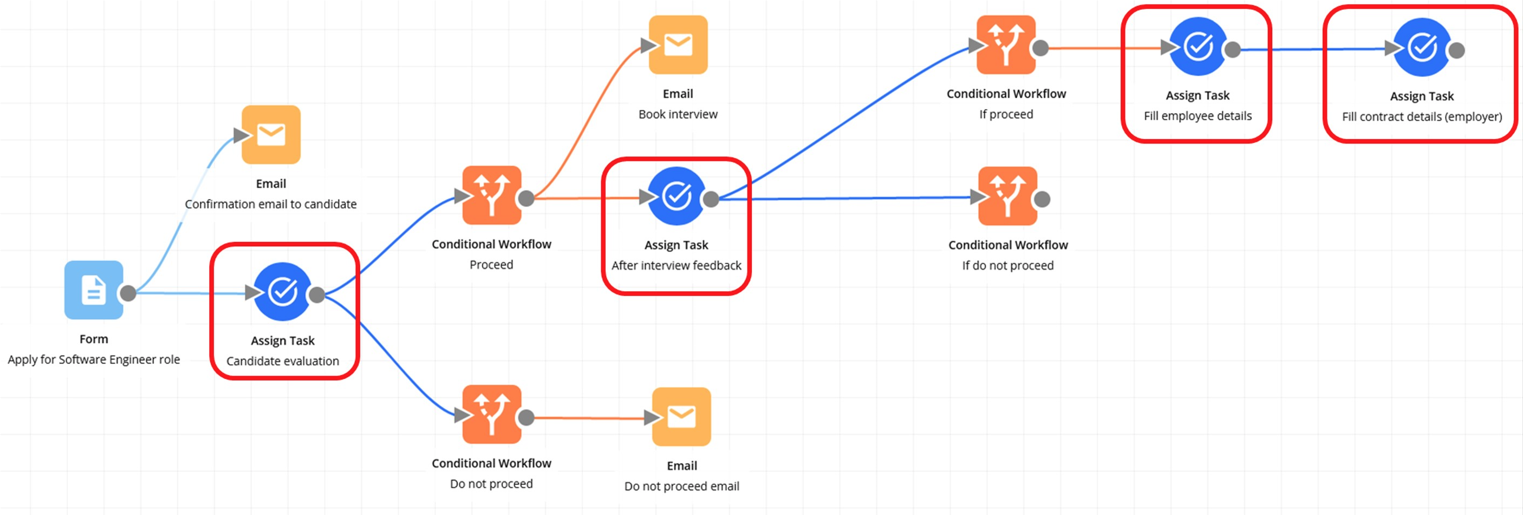
My Tasks page
All tasks that are created across your workflows are compiled together in the My Tasks page. Think of this as your streamlined inbox where all tasks which require your attention or action across all your different workflows are collected together for you to view, review and complete.
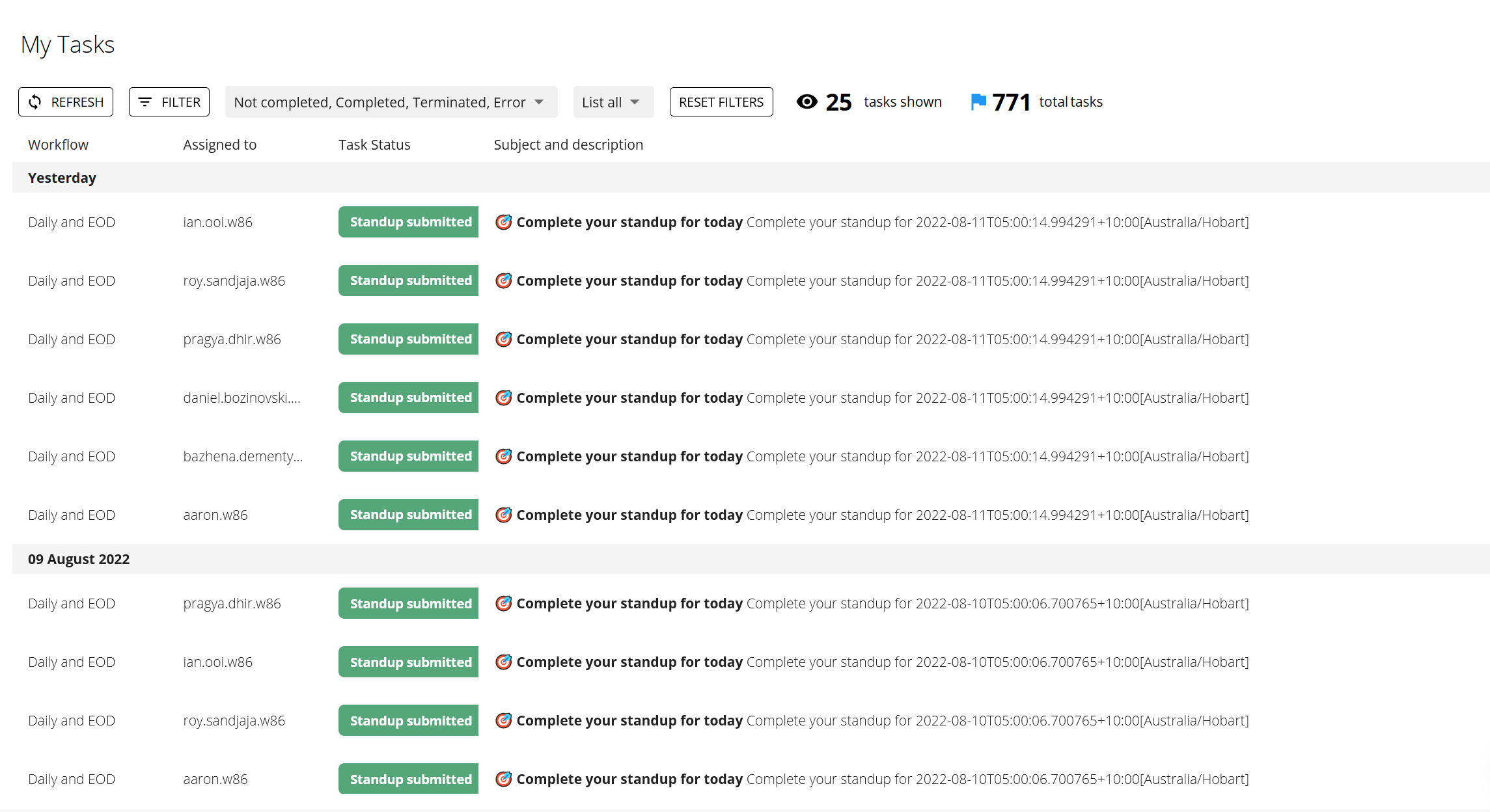
Learn more about the My Tasks page 👉 here
Notification method
The notification method sets how users are notified when a task is created.
Notify via email
When a task is created, users will receive an email that a task has been assigned to them, as well as have the task sent to their My Tasks page/inbox.
This mode also allows you to send tasks to external users who do not have a Workflow86 account under your organization.
Notify via task inbox
When a task is created, the task is sent to a user's My Tasks page/inbox only.
This mode only allows you to assign tasks to users with a Workflow86 account.
Assigning the task
Depending on the notification mode mentioned above, tasks can be assigned to users inside of your account, sent via email to external users without a Workflow86 account, or a combination of both. A task can also have no assigned users, in which case a record of that task will only be created in the My Tasks page.
What happens when a task is assigned?
When a task is assigned to a user, that task will be created and recorded in their My Tasks page. They will also get an email with the task subject and task description, and a link to the task page.
When a task is assigned to an external user (via their email), they will receive an email with the task subject and task description, and a link to the task page. A record of that task will be created and appear in the My Tasks page of any Administrator and Editor users in your account.
Assign to users
To assign tasks to users in your account, click on the field and select the users. You can also assign tasks to users via a placeholder if the placeholder is a username.

Assign to external users via email
You can also assign a task to an external user (someone outside of your account or who does not have a Workflow86 account) by specifying their email address.
Cc'ing others into task emails
You can Cc others into the task emails that get sent. A Cc does not assign the task to that user or email, it will only include them as a Cc into the email message itself. You can also Cc emails into the reminder emails as well.
Setting a reply-to email
You can set a reply email for any task emails or task reminders via the reply-to field. To set a reply-to email, either manually type in an email or set it via a placeholder:
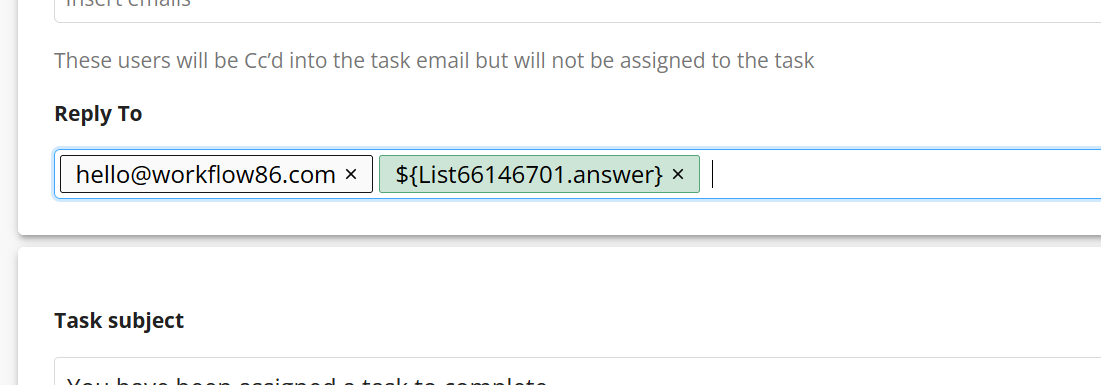
Selecting a custom email address to send messages
By default, emails from the Assign Task component are sent from the noreply@workflow86mail.com address. You can send emails from your own email address by adding an email (SMTP) credential to the Credential Store. Read about how to do this here
Once the email credentials have been added to the Credential Store, you can select it from the dropdown menu inside of the Email component. This will then send emails using the selected email address.
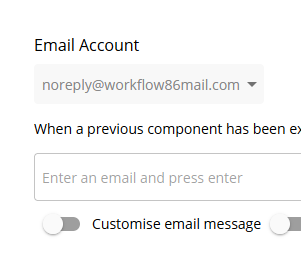

The Credential Store is a premium feature and is currently only available to users on paid plans.
Setting the task details
Task title and description
The task subject line or title is set here:

The description of a task is set here. You can use placeholders from other parts of the workflow inside of this description.

You can insert the link to the task by typing in "!" to insert the !{taskURL} placeholder. When the task is created, the link to that task will be inserted at the !{taskURL} placeholder.
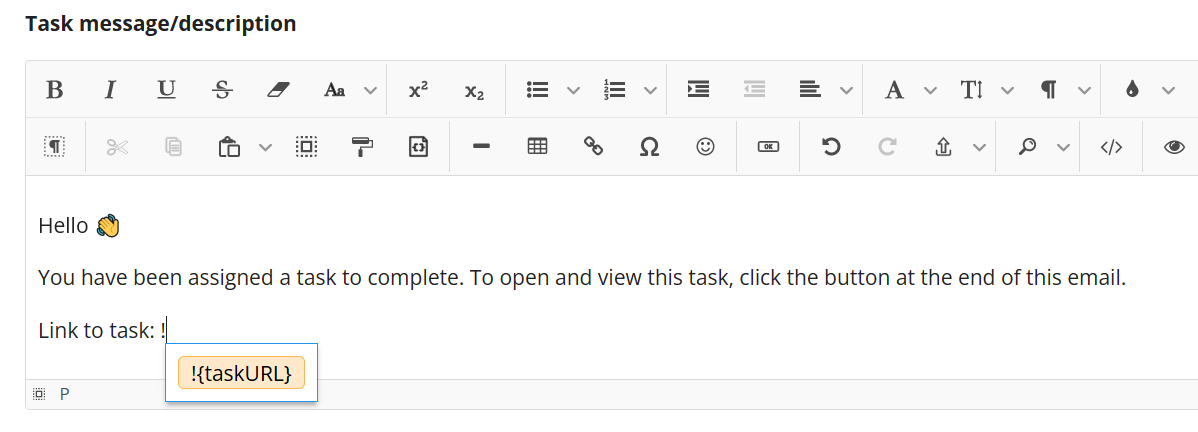
Customizing the task status
Every task has two statuses: a status for when it has not been completed, and a status for when it has been completed. By default, the statuses are set to "To do" and "Done". However, you can customize the labels for these statuses to whatever you want to reflect the task at hand:

Send reminder emails
You can set a reminder email to be sent if the form session has not been submitted after a certain amount of time e.g. send reminder email if the form session has not been submitted within 24 hours. To send a reminder email, turn on the "Send reminder email" buttonThis will open up additional fields at the bottom where you can set the recipient, content and time to send the reminder email.
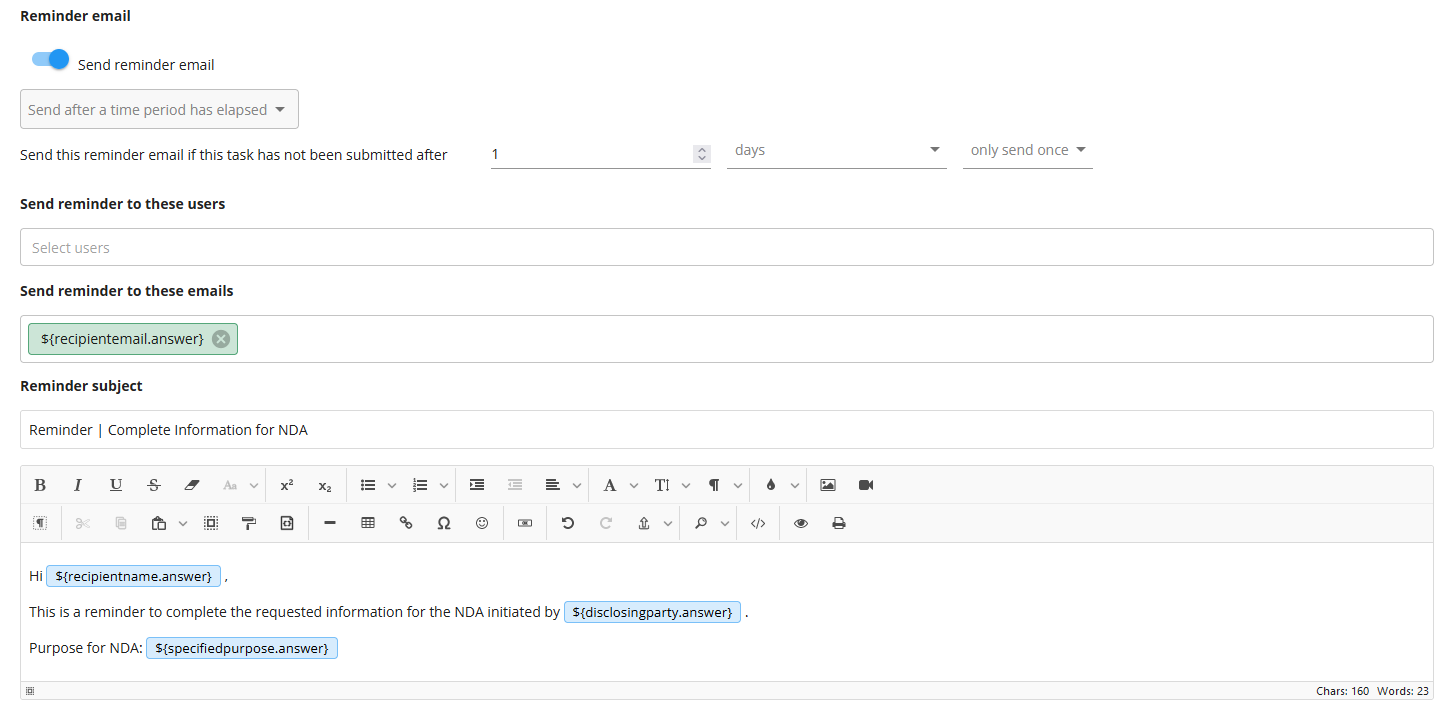
Building the task page
The task page is essentially a form that the user interacts with to complete the task. Building the task page is exactly the same as building pages in the form. Just drag, drop and configure the components on the right hand menu onto the page.
➡ Click here to go to the form builder docs
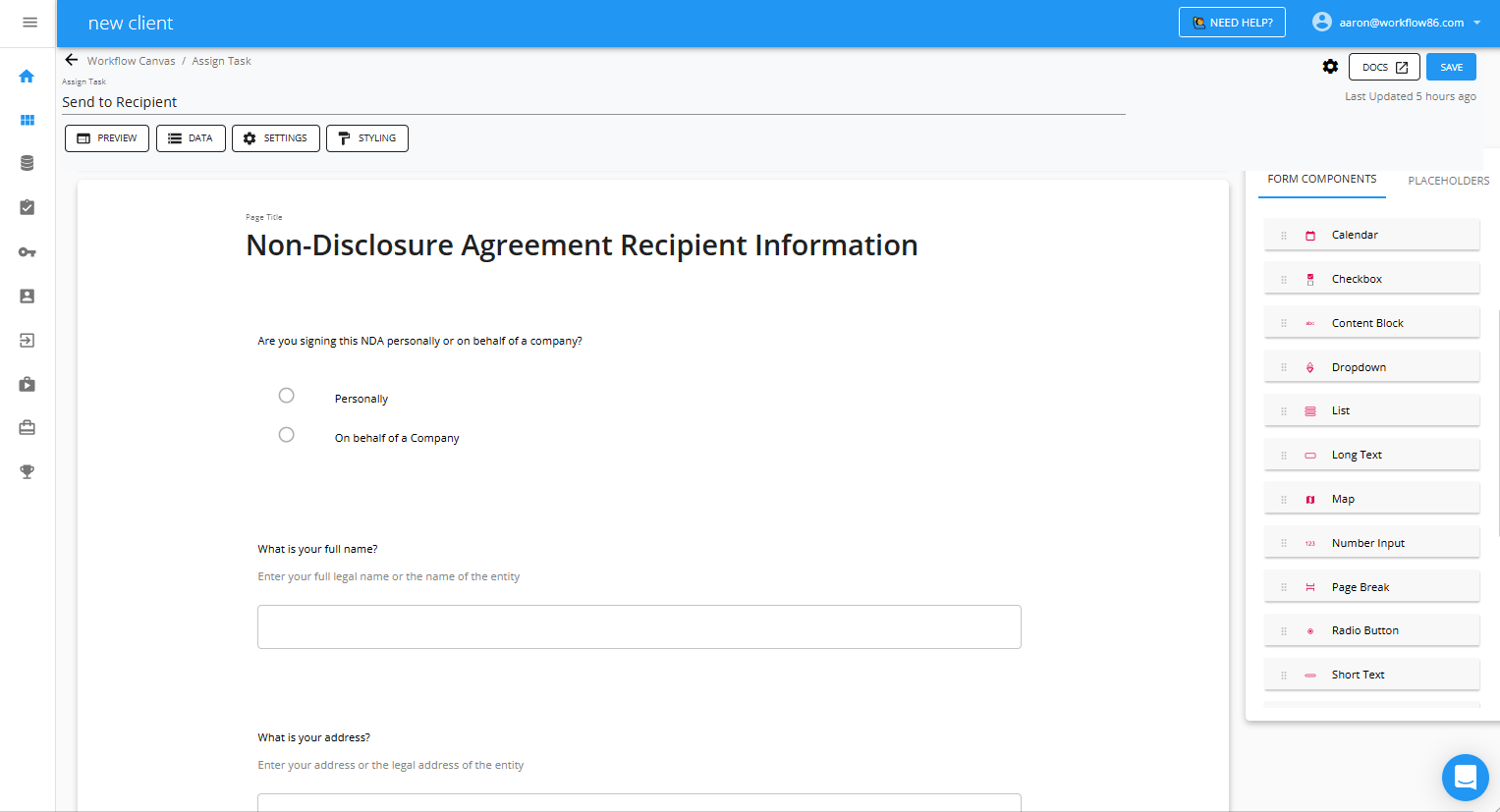
Using placeholders in the page
You can insert placeholders into the question text, description and context blocks of the task page. This allows you to use placeholders to dynamically render questions, descriptions or content inside of the task page.
Turn on the option to allow placeholders in the question text via the switch here:

You will also be prompted to turn it on if you have used placeholders in the form, but have not yet turned this switch on:
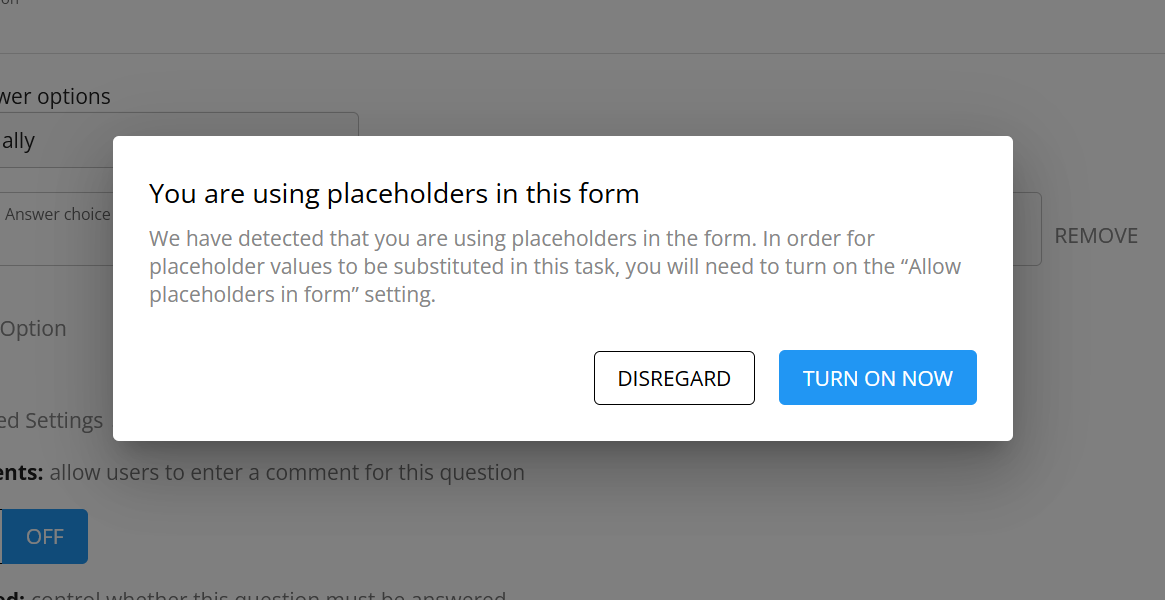
Once this has been turned on, you can insert placeholders by typing in "$" - this will bring up the placeholder options.

Simply click or select the required placeholder to insert it at the location where you typed the "$":
You can insert placeholders in the question text, question description, anywhere in the content block, as well as inside of the pre-determine answer option:
Make sure that you turn on the option to allow placeholders in the form settings BEFORE using placeholders. If this setting is not turned on, the placeholders will not be replaced with their value when the workflow is run.
This section refers to use of workflow placeholders inside of the Assign Task i.e. placeholders obtained from other components as part of the workflow. To see how you can use placeholders from other questions inside of the same form or task, see the section below.
Internal placeholders
In Forms, Form Sections and Assign Tasks, you can use internal placeholders to reference the answer of one question inside another question inside of the same form.
Read more about this feature 👉 here
Exposing the page metadata
The task page contains metadata (information and data about details like when it was submitted, form session ID etc) that can be exposed by setting a component label. By default, the task page does not have a component label and these metadata placeholders are not exposed. To set a component label, click the settings button in the top right:
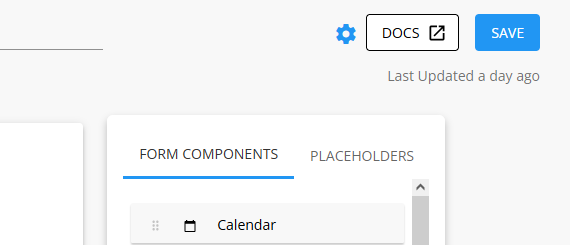
A dialog will appear - inside of the textfield, type in a component label. A component label can contain letters, numbers and underscores ("_") only.
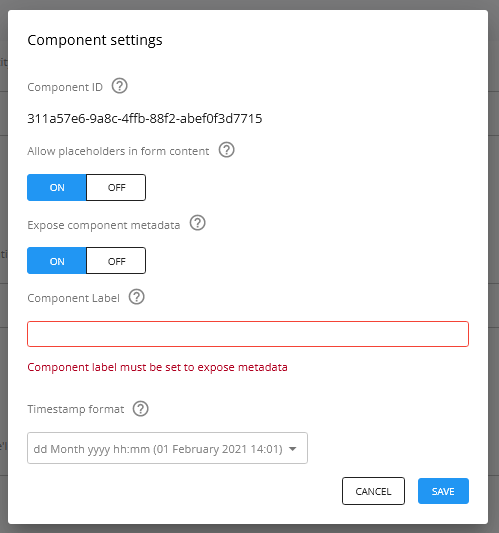
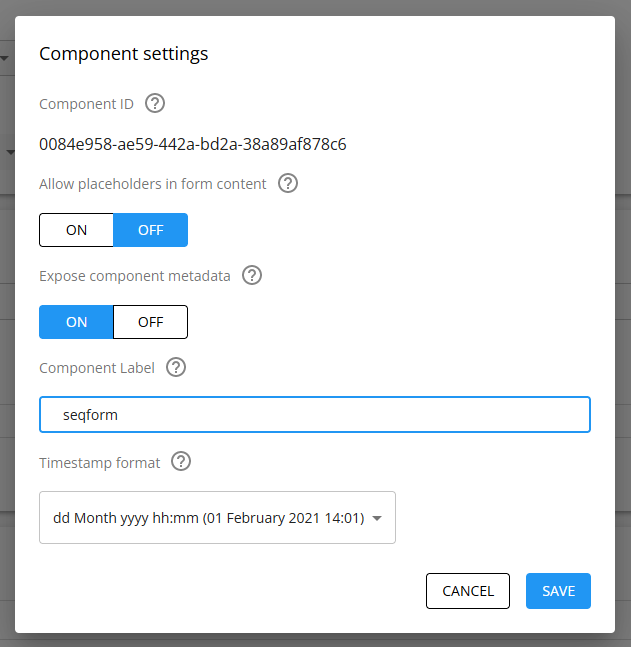
Setting a component placeholder will change all placeholder labels from this component i.e. ${placeholder} will not work, only ${component_label.placeholder} will work.
You will need to go through the workflow and update the old placeholders with the new placeholders containing the component label.
Metadata placeholders will now be exported by the Assign Task component:
projectSessionId is the session ID connected to the sequential form that has been submitted.
formSessionId is the form session ID connected to the sequential form that has been submitted.
formSubmittedDate is a time stamp of the date and time that the sequential form was submitted.
formSessionURL is the URL of the sequential form session that has been submitted.
You will also notice that all other placeholders from the sequential form now start with the component label in front:

Tracking your tasks on the My Tasks page
When a workflow session is run and it reaches an Assign Task component, a task will be created. This task and the corresponding link to the task page will be emailed to any users and emails specified in the component. It will also show up in the My Tasks page
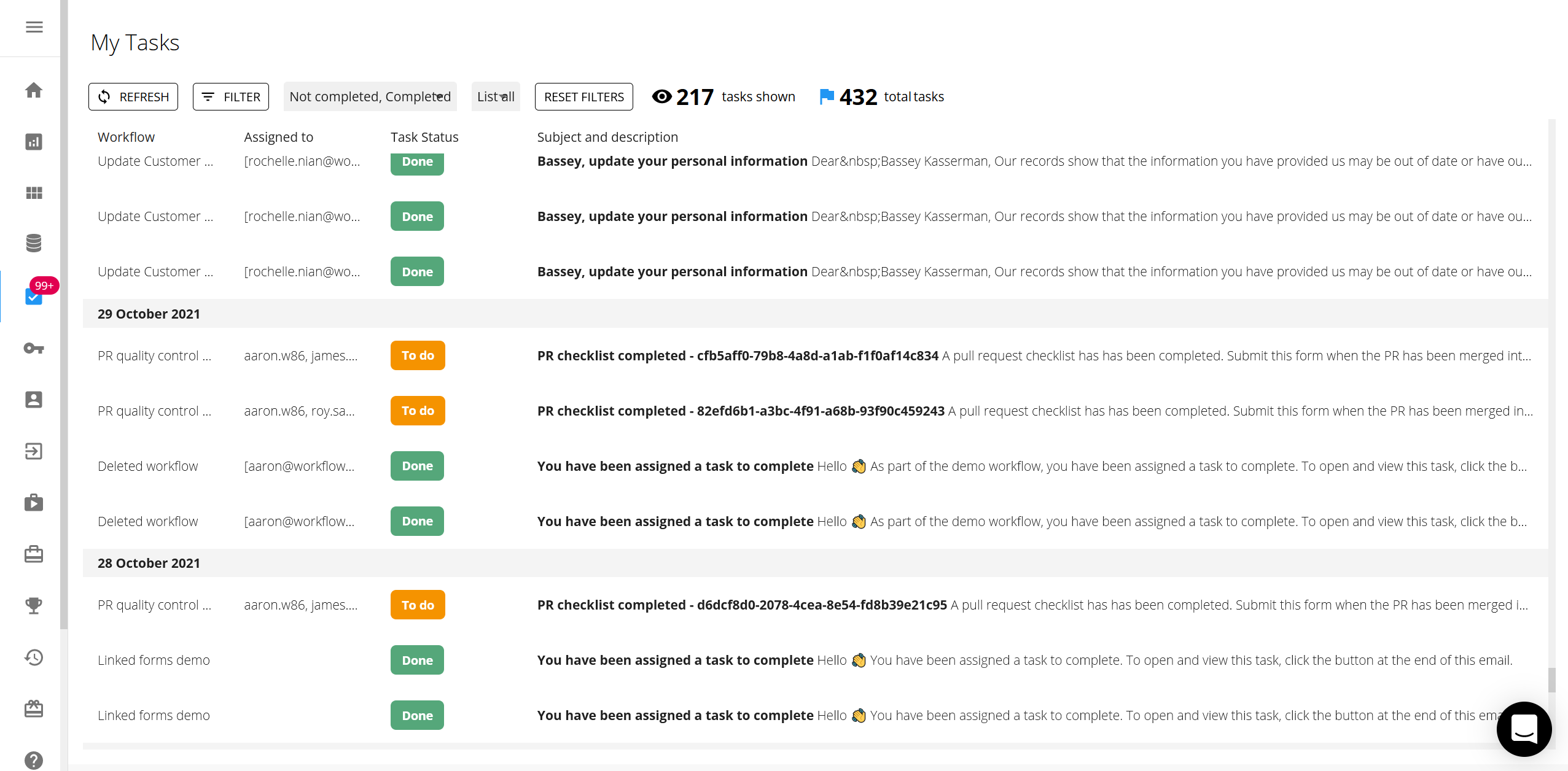
Click on a task in your inbox to view it in a reading pane on the right:

You can also fully expand this task to the full screen as well:
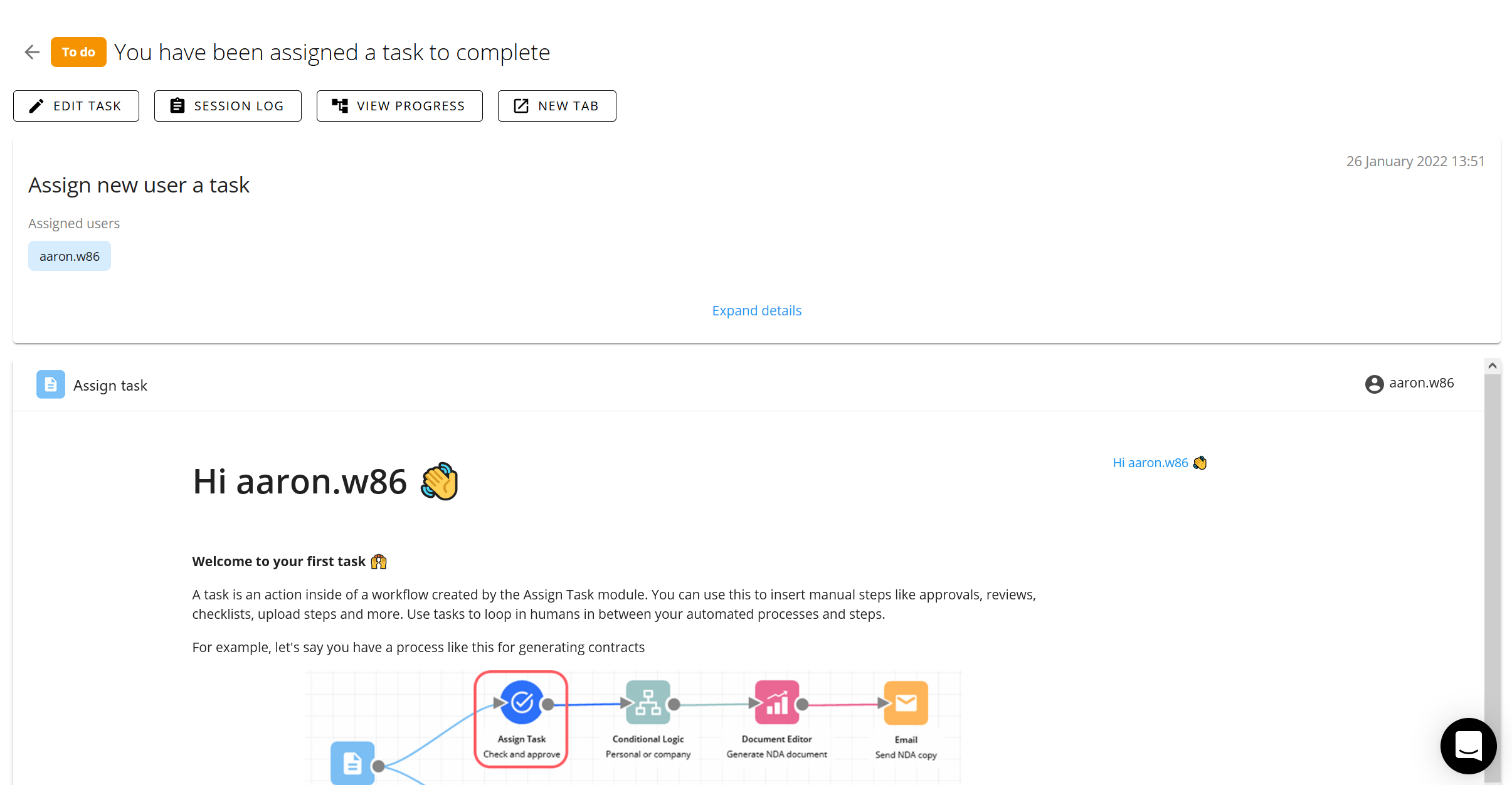
Viewing the task details
The task details contains information such as who is assigned the task, its subject title, description, due date and so on. To view the task details, open a task in the My Tasks inbox and then click "expand details"
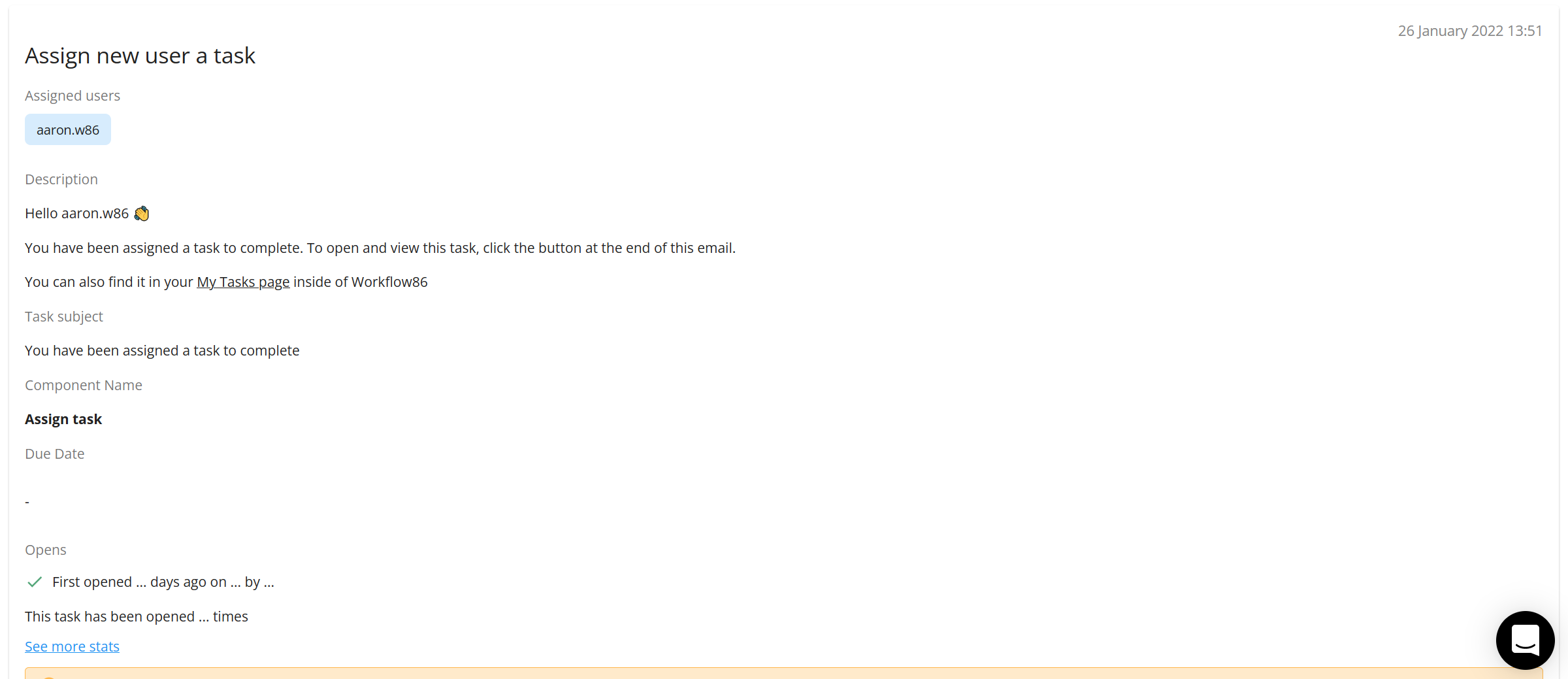
Editing task details
You can also edit the details of a task at any time, including changing who it is assigned to, the due date, the title and description. To edit a task, open a task in your My Task inbox and then click "Edit Task"
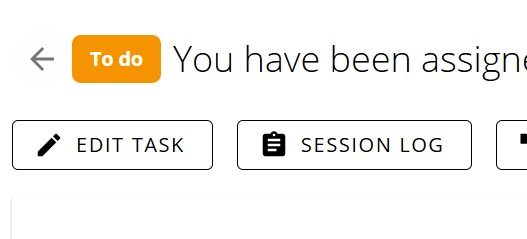

You can edit the fields and properties of the task:

Once you have finished editing the task, click "Save Edits" to complete:
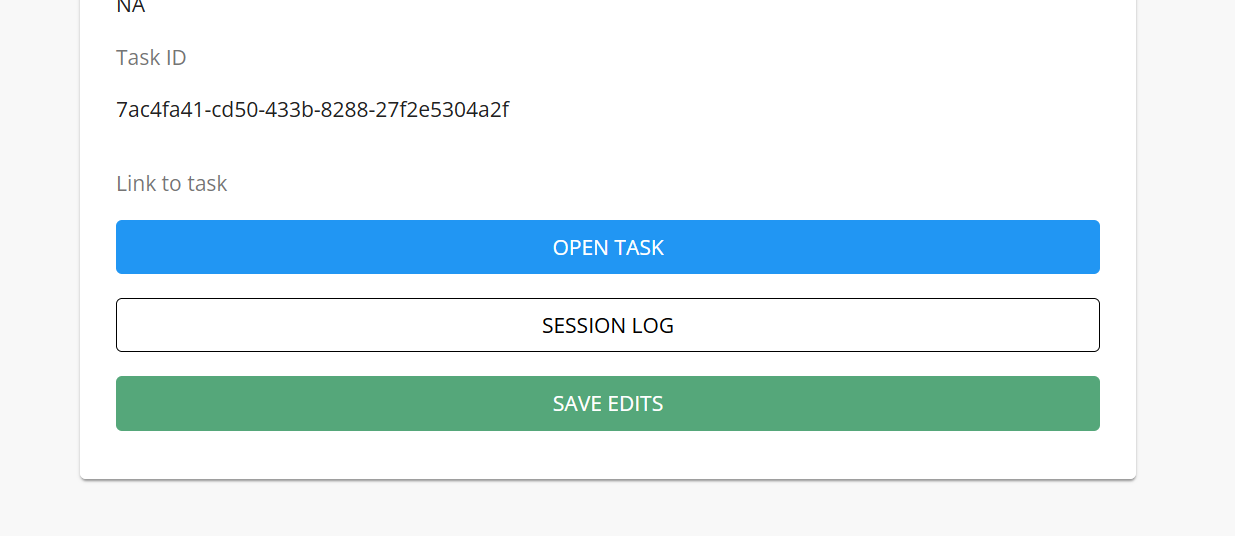
Who can view what tasks?
What tasks are displayed on your My Tasks inbox depends on whether you have been assigned a task, but also based on your role.
Admins
Admins can see all tasks assigned to any user in their organization, across all workflows. They can also see all tasks assigned to external users via email.
Editors
Editors can see all tasks assigned to them, and all tasks assigned to external users via email.
End User
End users can only see tasks assigned to them. They cannot see any tasks assigned to external users via email.
Terminate a task
You can cancel or terminate a task that is currently in progress or waiting to be submitted by navigating to the session log page. Find the session that you wish to terminate. You will see two terminate buttons:
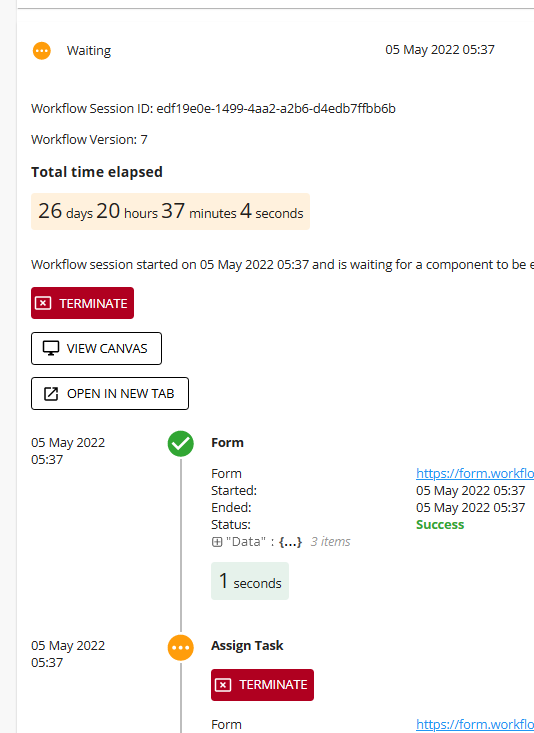
Terminate all tasks in a session
The terminate button at the top of the session log will terminate the entire session (i.e. all tasks)
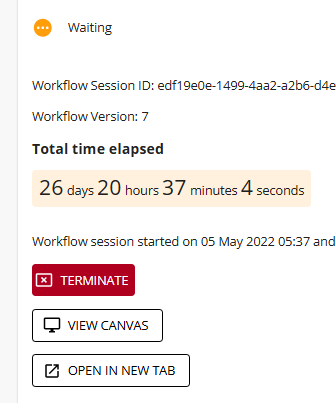
Terminate an individual task
If you want to only terminate a specific task in a session, the terminate button found in each Assign Task component will terminate just that Assign Task. Any other Assign Task components will not be terminated.
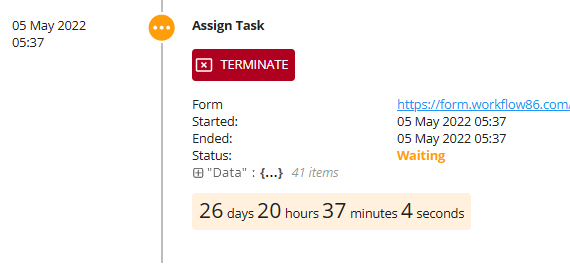
You can also terminate an specific task in a session by clicking on that task in the session progress view
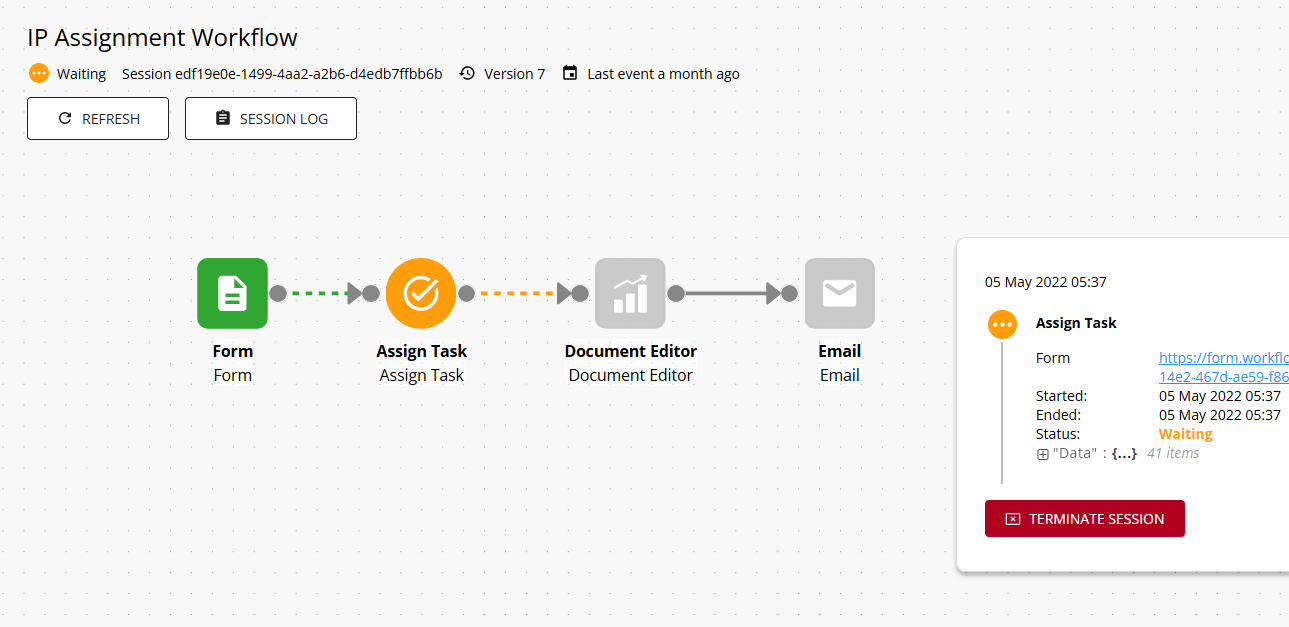
When a task is terminated, the link to that task is deactivated and can no longer be viewed or submitted.
Convert an Assign Task
An Assign Task can be converted into a Form or an Form Section component. Doing this will turn the Form component into a Form or Form Section while preserving all questions and form configurations.
When converting an Assign Task into a Form or Form Section, all task related settings such as assigned users, assigned emails, task subject, task description, due dates, reminder emails and so on will be lost.
To convert a Form Section, follow these steps here
Completing or submitting a task
A task operates the same way as you would a form using the Form Builder. When a workflow reaches an Assign Task step, it will create a task with its own URL. When the user navigates to that URL, it will open up the task for them to complete.

To complete or submit a task, click submit like as you would in a normal form. Once you click submit, the task is marked as complete and the workflow proceeds onto any subsequent actions.
Re-submitting a task
By default, tasks can be resubmitted as required by reloading the task link/URL. Resubmitting a task works exactly the same way as submitting a task - once submitted/re-submitted, the workflow will run all steps after the task.
For example, re-submitting the Assign Task in the workflow below will re-run the email component after it.
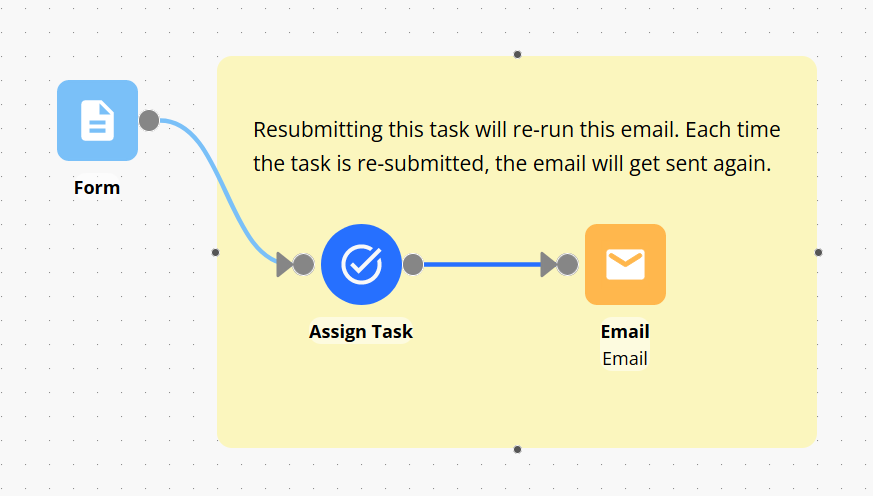
The ability to resubmit tasks effectively allows you to re-run parts of a workflow. This can be useful when you need to correct mistakes, update certain inputs or information, or simply to allow parts of a workflow session to be re-run as required.
What happens when I resubmit a task?
Resubmitting a task has the following impacts on the session and data associated with it. The following workflow has been run and completed, but we will re-submit the assign task:

Session data before the task was re-submitted is archived
When you resubmit a task, a "snapshot" of the session data before the resubmission is taken and then saved as a previous run of the workflow.
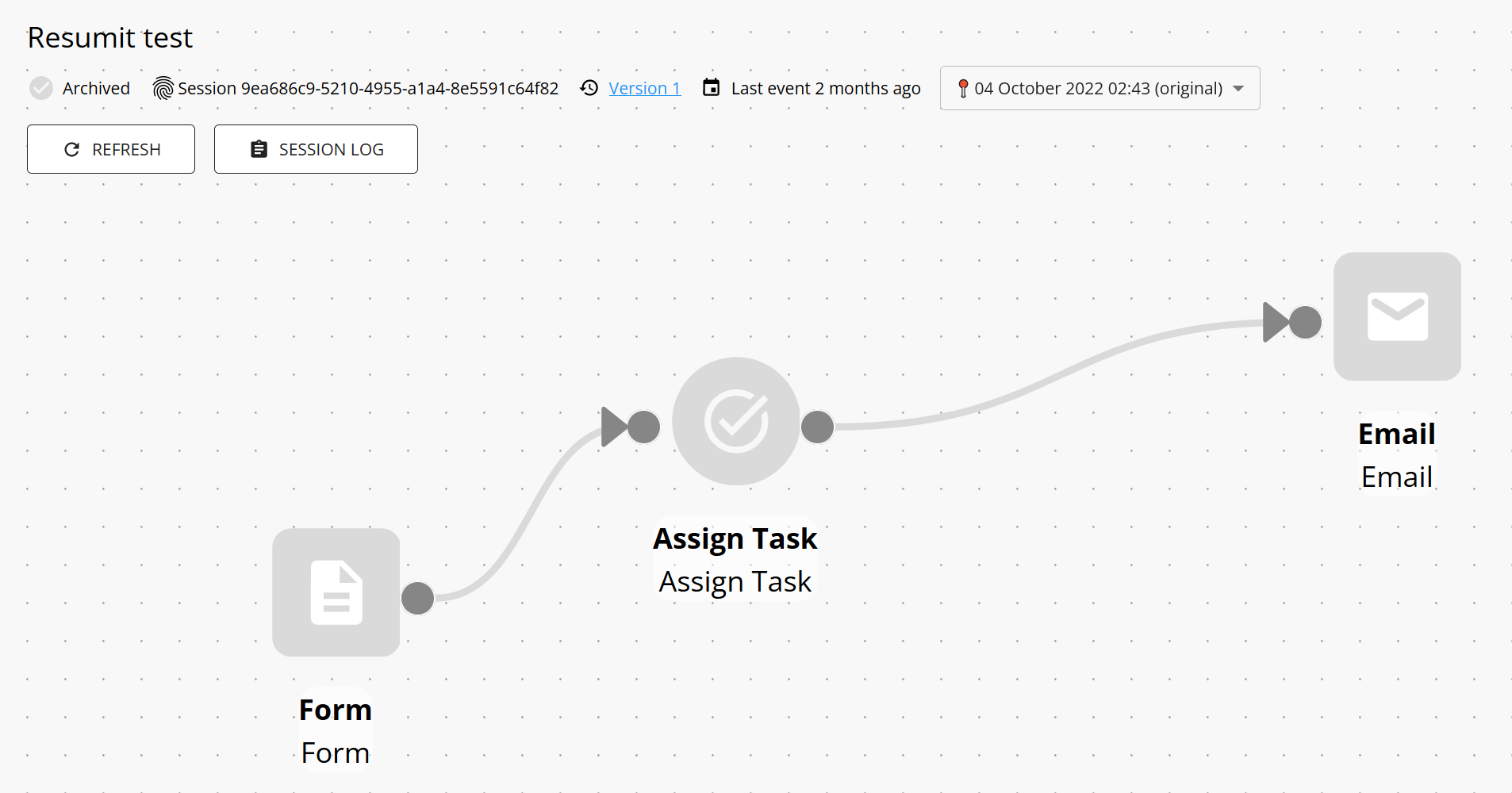
You can view previous runs of a session via the dropdown on the progress view:

A new session run is created
As the task is re-submitted and all components following the task are re-run, this is saved as the latest run of the session.
Any downstream tasks are terminated
If you have a workflow where there are components that are currently in a waiting state (for example, further tasks or time delays), these components will be terminated to prevent them from being doubled up due to the resubmission and re-run.
How to enable tasks to be resubmitted
The ability to re-submit a task is controlled by this switch in the form settings:
You can disable the ability to resubmit tasks by tuning this setting from ON to READ ONLY or OFF. This is useful when you want task to be single use only i.e. it can only be submitted once.
Turning this setting OFF will mean once the task has been submitted, it cannot be viewed again or re-submitted. Turning this setting to READ ONLY will mean navigating to the task URL will open a read-only version of the submitted task. This cannot be edited or re-submitted.
External tasks
Tasks can be assigned to you from another inside of your organization, or outside of your organization. When a task is assigned from a user outside of your organization, it is known as an external task. External tasks function the same as internal tasks (tasks assigned to you from workflows inside of your organization). You will find them in your task inbox, marked with a "[External]" in from of the subject line to let you know it is from a user outside of your organization.
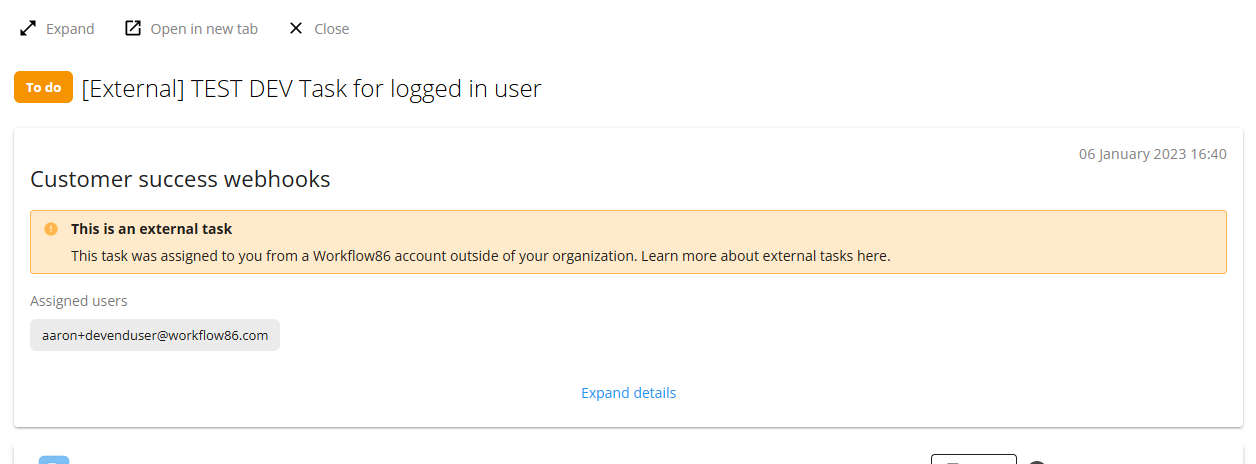
When you submit an external task, it triggers the next step in an external workflow. You cannot terminate, view the progress or navigate to the workflow canvas from an external task - this is because this task was created and sent from a workflow inside another organization.